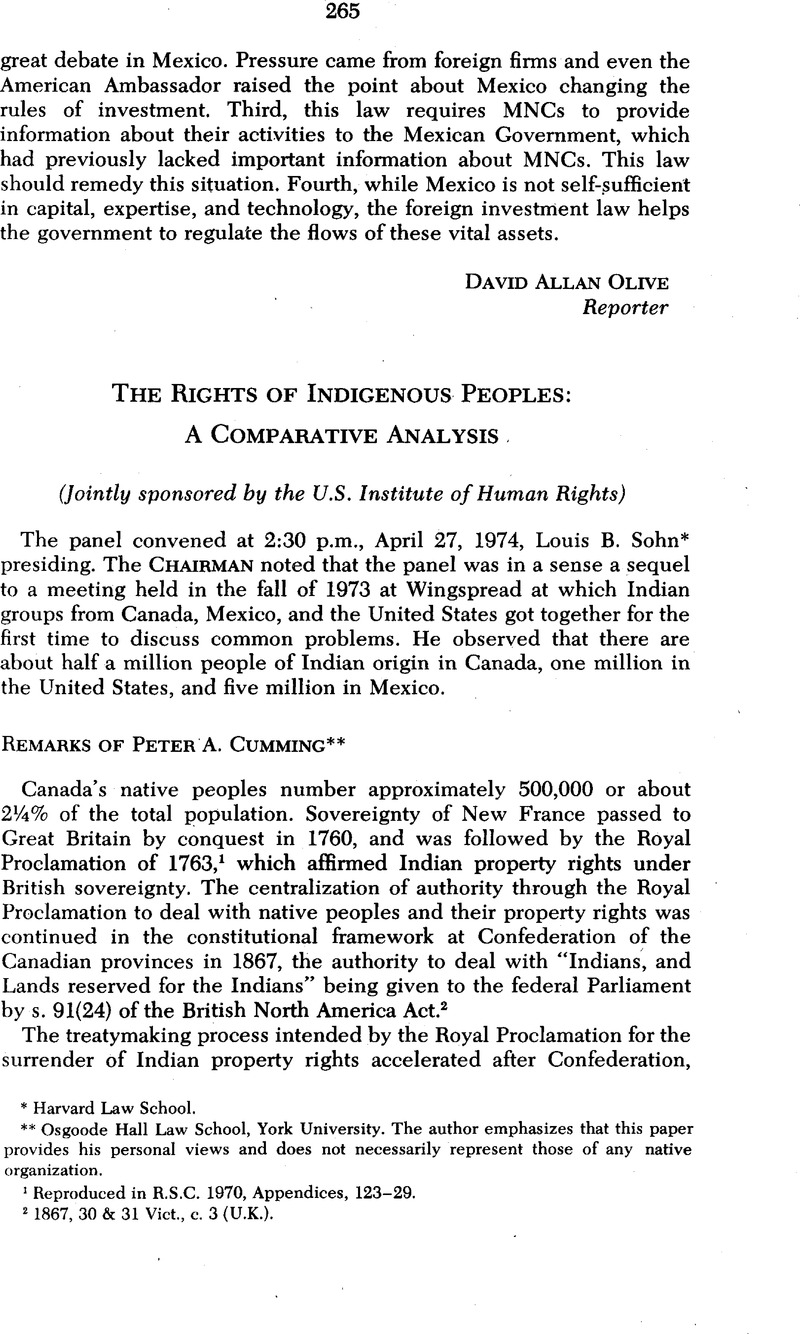No CrossRef data available.
Article contents
Chairman Louis B. Sohn
Published online by Cambridge University Press: 28 February 2017
Abstract

- Type
- The Rights of Indigenous Peoples: A Comparative Analysis
- Information
- Copyright
- Copyright © American Society of International Law 1986
References
1 Reproduced in R.S.C. 1970, Appendices, 123-29.
2 1867, 30 & 31 Vict., c. 3 (U.K.).
3 Attorney-General of Canada v. Attorney-General of Ontario [1897] App. Cas. 199 (P.C.), and R.v. Wesley, [1932] 4 D.L.R. 774, [1932] 2 W.W.R. 337 (Alta. App. Div.) constitute authority for the proposition that Indian treaties are of a contractual nature. R. v. Sikyea [1964] S.C.R. 642, (1965), 44 C.R. 266, affirming (1964), 43 D.L.R. (2d) 150, 46 W.W.R. 65 (N.W.T.C.A.), is a leading case which deals with a conflict between hunting rights given under a treaty and the terms of the Migratory Birds Convention Act (R.S.C. 1970, C. M-12). There the Supreme Court of Canada held that Parliament had the power to abrogate treaty agreements through its legislation.
4 R.S.C. 1970, c 1-6.
5 R. v. Drybones, [1970] S.C.R. 282, 9 D.L.R. (3d) 473; Attorney-General of Canada v. Lavell and Isaac v. Bedard (1974), 38 D.L.R. (3d) 481, 23 C.R.N.S., 197 (S.C.C.), reversing (.sub. nomRe Lavell and Attorney-General of Canada) [1972] 1 O.R. 396n, 22 D.L.R. (3d) 188 (Fed. C.A.) and (sub nomBedard v. Isaac) [1972] 2 O.R. 391 (Ont. H.C.) which reversed [1972] 1 O.R. 390, 22 D.L.R. (3d) 182 (Cty. Ct.); Canard v. Attorney-General of Canada (1973), 30 D.L.R. (3d) 9, [1972] 5 W.W.R. 678 (Man. C.A.); Isaac v. Davey [1973] 3 O.R. 677 (Ont. H.C).
6 R.S.C. 1970, Appendices, 457-60.
7 See Isaac v. Davey [1973] 3 O.R. 67 (Ont. H.C), at 690-91, per Osier, J.
8 This is illustrated in several cases: for example, R. v. Sikyea [1964] S.C.R. 642, (1965), 44 C.R. 266, affirming (1964), 43 D.L.R. (2d) 150, 46 W.W.R. 65 (N.W.T.C.A.), R. v. White and Bob (1965), 50 D.L.R. (2d) 613, 52 W.W.R. 193 (B.C.C.A.), The Queen v. George [1966] S.C.R. 267, 55 D.L.R. (2d) 386, R. v. Cooper (1969), 1 D.L.R. (3d) 113 (B.C.S.C), Daniels v. The Queen [1968] S.C.R. 517, (1969), 2 D.L.R. (3d) 1.
9 Department of Indian Affairs and Northern Development, Statement of the Government of Canada On Indian Policy(Ottawa: 1969).
10 See generallyHAROLD CARDINAL, THE UNJUST SOCIETY (1969).
11 Re Paulette et al and Registrar of Titles (No. 2) (1974), 42 D.L.R. (3d) 8, [1973] 6 W.W.R. 97.
12 Although Canada is a rich arid progressive country, the native peoples are at a distinct disadvantage, economically and socially, when compared with most of the members of white society. This is illustrated by E. R. McEwen, in Rights of Canada's First Citizens, a Resource Paper prepared for World Council of Churches Consultation on Racism, London, England, 1969(Indian-Eskimo Association of Canada, Toronto: 1969) 7-8. He cites statistics indicating that over 40% of Canada's native peoples are on relief, with 75% of Indian families earning less than $2,000 a year. The infant mortality rate among the Inuit and Indian people is twice the national average, while the average life expectancy is from one-third to one-half of that of the average Canadian. The levels of educational achievement are very low; for example, approximately 50% of Indian students do not go beyond Grade VI and about 61% fail to reach Grade VIII. Although these statistics were given in 1969, there is little indication that the situation in 1974 is significantly different.
13 International Labor Conference, 40th sess., Geneva, 1957, Convention 107 (Date of coming into force: June 2, 1959).
14 Ibid.,Article 1, paragraph 1(a).
15 Ibid.
16 Ibid.
17 Ibid.
18 International Labor Conference, 40th sess., Geneva, 1957, Record of Proceedings405.
19 Ibid.,at 406.
20 Letter dated February 14, 1958, addressed to Mr. A. H. Brown, then Deputy Minister, Federal Department of Labour, from Mr. W. R. Jackett, then Deputy Attorney-General, Department of Justice.
21 The Federal Government has the power to enter into the Convention, subject to ratification by Parliament. Once ratified, the Federal Government has the power and duty to implement the Convention within the sphere of federal legislative competence. SeeAllan Gotlieb, The Changing Canadian Attitude to the United Nations Role in Perfecting and Developing Human Rights,in ALLAN GOTLIEB (ed.), HUMAN RIGHTS, FEDERALISM AND MINORITIES 16-53 (1970). Section 91(24) of the British North America Act gives legislative competence in respect to native peoples and their lands to Parliament. Moreover, the Northwest Territories and the Yukon territory are areas of solely federal jurisdiction and there is no constitutional limitation upon federal power. SeeBritish North America Act, s. 146, and Order-in-Council of June 23, 1870, reproduced in R.S.C. 1970, Appendices 257-63.
22 Letter dated September 5, 1972, addressed to Mr. Bob Gamble, Executive Assistant, Inuit Tapirisat of Canada, from Mr. Martin O'Connell, then Minister of Labour in the Federal Government.
23 Inuit Tapirisat of Canada (Ottawa: 1972).
24 Department of Indian Affairs and Northern Development (Ottawa: 1972).
25 International Labor Conference, 40th sess., Geneva, 1957, Recommendation 104.
26 Ibid.
27 Adopted by General Assembly Resolution 217A(III) Dec. 10, 1948.
28 Proclaimed by the General Conference of the United Nations Educational, Scientific and Cultural Organization, 14th sess., Nov. 4, 1966.
29 Adopted and opened for signature and ratification by General Assembly Resolution 2106A(XX) Dec. 21, 1965 (Date of coming into force: Jan. 4, 1969).
30 Department of Indian Affairs and Northern Development, Statement on Claims of Indian and Inuit People(Ottawa: 1973).
31 Alaska Native Claims Settlement Act, 85 Stat. 688 (1971), 43 U.S.C. §1601-1624 (1973).
32 Experience in the United States suggests that the use of numerical standards and quotas over a transitional period is necessary to achieve equality in fact. SeeAlfred W. Blumrosen, Quotas, Common Sense and Law in Labor Relations: Three Dimensions of Equal Opportunity,an unpublished paper presented at the Annual Public Lectures, 1973/74, at Osgoode Hall Law School, York University, February, 1974.


